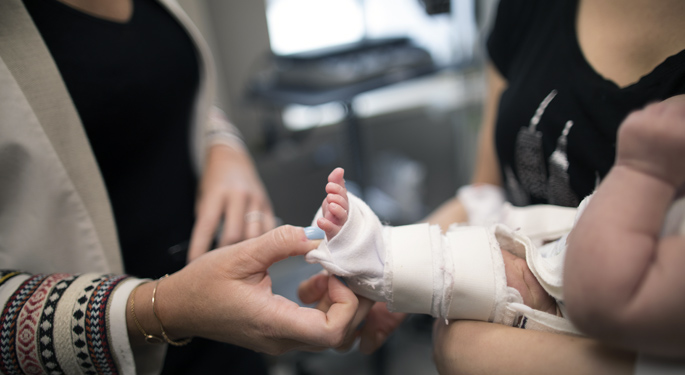Pediatric Orthopedics and Scoliosis Conditions We Treat

Mount Sinai’s pediatric orthopedics team is skilled in treating scoliosis as well as the full range of conditions affecting the growing musculoskeletal system, including:
- Cerebral palsy (CP) is a complex disease process that makes it difficult to control muscles, causing disability. Children with mild CP may be able to walk on their own, while those with severe CP may have to use a wheelchair.
Treatments for CP include medication, physical therapy, braces, and in some cases, surgical management, which can help preserve, prolong, and sometimes improve your ability to move independently.
- Clubfoot, occurring in approximately 1 in 1,000 births, causes the foot to turn to the side, with the affected foot, calf, and leg being smaller than normal. Clubfoot is not painful, but, if untreated, the condition could lead to disability as your child grows.
It is important that we treat your child’s clubfoot as soon as possible to ensure the best outcome. Therapies that involve casting and bracing have been increasingly successful in correcting this condition without surgery.
- Developmental dysplasia or dislocation of the hip (DDH) happens when the ball of the hip does not fit the hip socket. This can cause legs of differing lengths, decreased mobility, and limping. In mild cases, the ball is loose in the socket; in severe cases, the ball is completely dislocated.
Our treatment for DDH depends on when we start treatment. In early infancy, we can use a harness or brace. If we discover the condition when you’re an older child, we may need to use surgical procedures to manage the condition.
- Fractures/injuries can result from any injury forceful enough to break a bone. Fractures can occur in the upper and lower extremities. Ten percent of all arm fractures in children occur around the elbow.
We tailor our treatment of fractures to the nature of the injury, attempting non-surgical management using casting and in-office procedures such as wedging of casts to appropriately manage fractures in the least invasive way possible. Occasionally, we cannot manage a fracture with non-operative techniques.
- Osteogenesis imperfecta (OI) means that your child’s body is unable to make strong bones, which could cause deformities and lead to frequent breaks and fractures. Caused by a genetic defect, your child’s OI can occur in a mild or severe form.
We treat for OI with nonoperative therapies, such as medication and exercise, or surgically, by inserting metal rods.
- Osteomyelitis is an infection that occurs in your child’s bones. It is essential that you get timely medical care to keep the condition from becoming chronic or recurring.
We use a team approach to treat osteomyelitis, using antibiotics, and, when necessary, surgical management to remove infected tissue and allow the infection to heal.
- Overuse injuries are becoming more common as children participate more and more in single sporting activities. Participating in repetitive activities without sufficient rest or stretching can lead to overuse injuries that can affect your child’s growth plates, ligaments, muscles, and tendons. It is good to understand that children’s bones grow before their muscles and tendons do, which can put strain on the muscles and tendons. Overuse injuries include jumper’s knee, throwing injuries to the elbow, and stress fractures.
We treat various overuse injuries with stretching exercises, non-steroidal anti-inflammatory medication, immobilization, casting, bracing, and, when necessary, surgery.
- Rickets and osteomalacia happen due to low levels of vitamin D and cause bone weakness, pain, and deformities. Identifying the root cause of your child’s abnormal bone growth is crucial, and with the help of Mount Sinai’s pre-eminent genetics department, we identify and cater our treatment plan to your child’s specific needs.
- Scoliosis is common in children and adolescents. Scoliosis is a sideways curve in the spine that could resemble an “s” or “c” shape.
We treat scoliosis based on your child’s age, the extent of the curvature, and how it affects your child. In many cases, treatment may involve monitoring your child’s spine with regular X-rays or by using a brace. For more severe cases, we correct the curve with surgery.